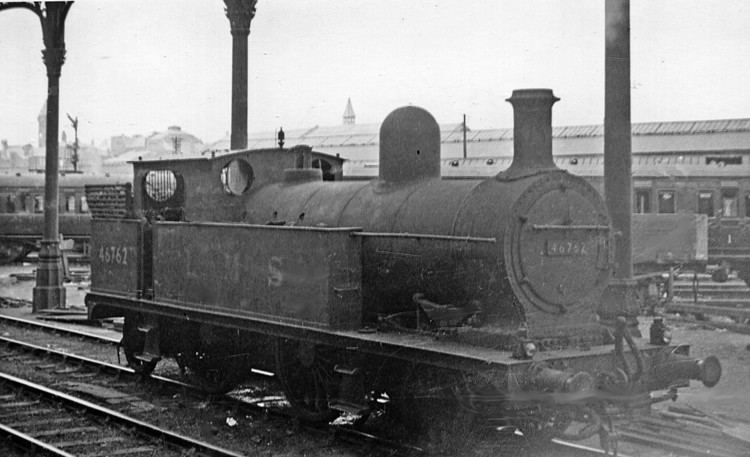Power type Steam Total produced 310 | Designer J. A. F. Aspinall Build date 1889–1911 | |
 | ||
Order number Lots 1, 4, 11, 12, 16, 22, 27, 28, 30, 34, 35, 36, 38, 41 | ||
The Lancashire and Yorkshire Railway Class 5 and Class 6 were two related classes of 2-4-2T steam locomotives.
Contents
Class 5
The class began as a John Aspinall design of 1889. The first locomotives had 18-by-26-inch (457 mm × 660 mm) cylinders for a tractive effort of 18,955 lbf (84.32 kN) and power class 2P. Some later-built locomotives from 1893 had smaller diameter cylinders of 17 inches (432 mm) for a tractive effort of 18,360 lbf (81.67 kN). The original coal bunker capacity was of 2 tons. From 1898, some were rebuilt with increased capacity for both water and now 4 tons of coal. 270 were built in total.
In 1905, Hughes introduced a Belpaire firebox to replace the original round-topped boiler. 40 were built. From 1910, this boiler was also fitted to rebuilt locomotives.
110 eventually came into British Railways hands in 1948. By 1961, all but three had been scrapped.
Some of these locomotives were also fitted for push-pull working, being coupled to a driving trailer coach that contained a driver's cab and allowed the train to be driven in reverse, without running the locomotive around the train at the terminus.
Druitt Halpin experiments
One locomotive, 632, was built by Hoy in 1902 with an experimental Druitt Halpin thermal storage apparatus. Similar in some respects to a Flaman boiler, this resembled a second short boiler drum atop the normal drum, in place of the dome. Other locomotives: 1015, 1164, 1315, 1335 & 1375 were similarly fitted in 1905. Ivatt also experimented with a similar device on a GNR 2-4-0. Neither appears to have been successful and after problems with mud and scale build-up, Hughes had them removed.
1906 boiler explosion
In 1906, class 5 no. 869 suffered a boiler explosion at The Oaks station, north of Bolton. The firebox crown sheet broke free of its rod stays and burst downwards, although without splitting. 57 of the 150 one-inch (25-mm) rod stays failed, the steam escaping through the remaining holes scalding the driver, although both footplate crew survived their injuries. The cause of the accident, which was the L&YR's second major boiler explosion in five years, was put down to poor washing out of the firebox water spaces when at Colne shed. Afterwards, 72 pounds (33 kg) of scale was collected. Although boilers were supposed to be washed out every eight days, this quantity suggests that it was up to three weeks since this had last been done thoroughly, either through omission or by inadequate washing.
Wirral Railway
The Wirral Railway (WR) acquired one of these locomotives from the L&YR in June 1921: no. 1041 became WR no. 6. After the Grouping of 1923, this re-joined its original stablemates as part of the newly created London, Midland and Scottish Railway. Although the L&YR locomotives were numbered in a block from No. 10621 upwards, which included the allocation of no. 10638 to the original L&YR number of the Wirral locomotive, the former Wirral locomotive stock was included in the LMS Western Division. The largest constituent of the Western Division was the LNWR, and so WR no. 6 was numbered 6762 by the LMS, at the end of a block starting at 6515 which was allocated to former LNWR 2-4-2T locomotives; this locomotive followed on from nos. 6758–61, four former LNWR 4′ 6″ 2-4-2T which the WR had acquired from the LNWR.
No. 6762 survived into British Railways ownership (as 46762) and worked as station pilot at Preston, until being withdrawn and scrapped in 1952. It was the only Wirral Railway engine to last until Nationalisation; it also retained the original round-topped boiler throughout.
Preservation
The first of the class, No. 1008 is preserved as a static exhibit in the National Railway Museum.
Class 6
The L&YR Class 6 was a superheated development by George Hughes of the Aspinall L&YR Class 5.
Some were rebuilt as conversions and others built new. 20 new locomotives were built in 1911. Of the conversions, 26 were of the Aspinall engines, 18 of Hughes' own version with Belpaire firebox.
The locomotives passed to the London, Midland and Scottish Railway (LMS) in 1923. LMS numbers were 10900–10954, except for 9 which were converted after the grouping without being renumbered. Fourteen of the class came into British Railways hands in 1948 and were numbered in the range 50835–50953.
All had been scrapped by 1952.
